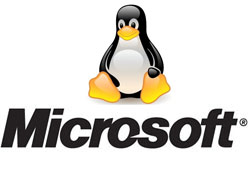It may be true that Microsoft is not a big Apple fan, but when it comes to its other competitor, Linux, the Redmond-based company is showing its softer side – and by that I mean Microsoft contributed 20,000 lines of device driver code to the Linux community. The code will be added to the Linux tree and includes three Linux device drivers which will be made available to Linux users free of charge of course.
The purpose of this move is to get Windows Server 2008 Hyper-V or Windows Server 2008 R2-powered machines to provide enhanced performance when running virtualized Linux operating systems. In this regard, Microsoft not only contributed Hyper-V drivers to the Linux kernel, it also opened its Linux Hyper-V drivers under General Public License v2.
Director of Microsoft’s Open Source Technology Center, Tom Hanrahan, comments: “We’re releasing Linux device driver code to the Linux kernel community. This is a significant milestone because it’s the first time we’ve released code directly to the Linux community. Additionally significant is that we are releasing the code under the GPLv2 license, which is the Linux community’s preferred license. Our initial goal in developing the code was to enable Linux to run as a virtual machine on top of Hyper-V, Microsoft’s hypervisor and implementation of virtualization. The Linux device drivers we are releasing are designed so Linux can run in enlightened mode, giving it the same optimized synthetic devices as a Windows virtual machine running on top of Hyper-V. Without this driver code, Linux can run on top of Windows, but without the same high performance levels.”
According to Senior Director of Platform Strategy, Sam Ramji, the operating systems developed by Microsoft and the Linux community are used by a lot of people all over the world. With this release Microsoft is following a well defined strategy: to enhance interoperability between the Windows platform and open source technologies. And the thing that spurred this strategy is the current economic climate and the need to consolidate one’s hardware and software assets.
“The current economic climate has a lot of companies consolidating their hardware and software assets, deferring new software and hardware purchases, and reducing their travel and training expenses — doing everything they can to cut controllable costs to the bone and get the most out of what they’ve got so they can hang onto their skilled staff. Many companies are turning to Microsoft more frequently to help them succeed in a heterogeneous technology world because we understand that reducing complexity is a key factor to reducing cost. We are seeing interoperability as a lever for business growth. So there’s mutual benefit for customers, for Microsoft, and for commercial and community distributions of Linux, to enhance the performance of Linux as a guest operating system where Windows Server is the host,” explained Sam Ramji.
One other benefit is that if you are running Linux in a Windows host environment, these Linux device drivers will help you consolidate your Linux and Windows servers on a single virtualization platform – which in turn reduces the complexity of your current infrastructure.
The purpose of this move is to get Windows Server 2008 Hyper-V or Windows Server 2008 R2-powered machines to provide enhanced performance when running virtualized Linux operating systems. In this regard, Microsoft not only contributed Hyper-V drivers to the Linux kernel, it also opened its Linux Hyper-V drivers under General Public License v2.
Director of Microsoft’s Open Source Technology Center, Tom Hanrahan, comments: “We’re releasing Linux device driver code to the Linux kernel community. This is a significant milestone because it’s the first time we’ve released code directly to the Linux community. Additionally significant is that we are releasing the code under the GPLv2 license, which is the Linux community’s preferred license. Our initial goal in developing the code was to enable Linux to run as a virtual machine on top of Hyper-V, Microsoft’s hypervisor and implementation of virtualization. The Linux device drivers we are releasing are designed so Linux can run in enlightened mode, giving it the same optimized synthetic devices as a Windows virtual machine running on top of Hyper-V. Without this driver code, Linux can run on top of Windows, but without the same high performance levels.”
According to Senior Director of Platform Strategy, Sam Ramji, the operating systems developed by Microsoft and the Linux community are used by a lot of people all over the world. With this release Microsoft is following a well defined strategy: to enhance interoperability between the Windows platform and open source technologies. And the thing that spurred this strategy is the current economic climate and the need to consolidate one’s hardware and software assets.
“The current economic climate has a lot of companies consolidating their hardware and software assets, deferring new software and hardware purchases, and reducing their travel and training expenses — doing everything they can to cut controllable costs to the bone and get the most out of what they’ve got so they can hang onto their skilled staff. Many companies are turning to Microsoft more frequently to help them succeed in a heterogeneous technology world because we understand that reducing complexity is a key factor to reducing cost. We are seeing interoperability as a lever for business growth. So there’s mutual benefit for customers, for Microsoft, and for commercial and community distributions of Linux, to enhance the performance of Linux as a guest operating system where Windows Server is the host,” explained Sam Ramji.
One other benefit is that if you are running Linux in a Windows host environment, these Linux device drivers will help you consolidate your Linux and Windows servers on a single virtualization platform – which in turn reduces the complexity of your current infrastructure.

























